Dashcams: tips, reviews and videos from the road
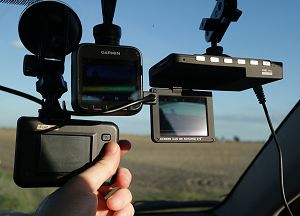 Introduction to dashcams Introduction to dashcams
"Dashcams" (sometimes called car cameras or driving cameras) are small, self-contained digital video cameras built for one purpose: to continuously capture a view of the road during the operation of a motor vehicle, providing an ironclad video record of events. They're essentially miniature CCTV cameras for cars and trucks.
At right: three different dashcam models.
In the US, dashcams have been traditionally associated with older analog VCR-based systems used in police vehicles. More recently, the modern digital dashcam has been a phenomenon on the dangerous and insurance-fraud-rife highways of Russia, where nearly every driver owns at least one. But they're beginning to catch on worldwide. Even here in the US, an explosion in the number of dashcams in use has taken place over the past couple of years. As prices come down and more capable models are released, I expect that one day dashcams will be commonplace on the roads in the USA.
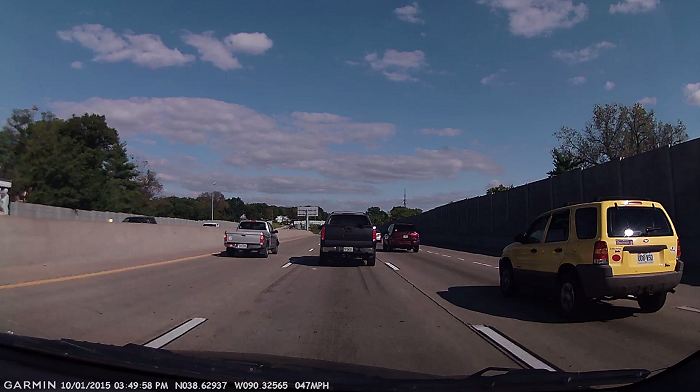
The typical view recorded by a dashcam.
I'm a storm chaser that logs many thousands of miles a year, so I have been running dashcams of one sort or another continuously since 2007. My reasons for employing dashcams are twofold: 1.) to capture interesting and compelling footage of events that happen on the road and in the sky, and 2.) as ironclad proof of what happened in the event of an accident or other incident. I started out in 2007 with a single-camera police car-style analog VCR system. Now, I have four: one modern digital dashcam pointing out each direction (front, rear, driver's and passenger sides). Just about anything that happens to my car or anywhere near my car will be captured on camera.
My dashcam footage has been helpful. For example, I was recently able to directly refute negative news coverage alleging that storm chasers were constantly causing problems clogging Kansas highways. You can't argue with video - it is a powerful witness that can be your advocate in a court of law and the court of public opinion.
Back in 2013, this section of my site started out as a blog post on my experiences in shopping for/buying, installing and using dashcams. It has turned out to be one of my site's more high-traffic pages, so in October of 2015, I gave it this overhaul to better organize and expand on the various sections.
Types of dashcams and their pros/cons
There are several types of dashcam units and systems available. The right one for you depends on what you drive and/or how many camera views you want.
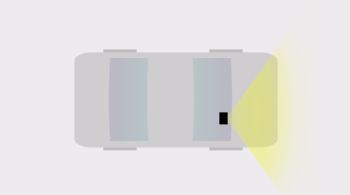
Single-camera digital recorder, self-contained unit: These are the most common type of dashcam and the type that will best suit most drivers. Mounting to the windshield via a suction cup and powered via a standard cigarette lighter plug, these cameras record video/audio of the view to the front of the car. The video is captured continuously whenever the vehicle's ignition is on. Video files are stored on a memory card, with the newest video continuously replacing the oldest video (called loop recording). After installation, the camera requires no user input or intervention - it turns on when the ignition is on, and stops when the vehicle is shut off. In the event of an accident or other incident, the camera can be hooked up via USB to a computer to download the video for safekeeping, or, the memory card can be removed and secured.
Most dashcams of this type available today record in full 1080 high-definition, which can allow license plates on adjacent vehicles to be read. The recording loop (the amount of time on the video record) is dependent on the size of the memory card. With a 32GB card, most dashcams can support a 4 to 7 hour recording loop (depending on the bitrate) at 1080p resolution. Even longer loops can be attained if the camera is set to record at lower resolutions (720p, 640x480, etc).
Expect to pay between $150 - $250 for a quality single-camera 1080p dashcam with all of the essential features from reputable US-based sellers or retailers. You can sometimes save as much as 50% by purchasing an equivalent or similar model direct from a Chinese or Taiwanese seller/manufacturer, but this is risky as your recourse in the event of problems will be much more limited. Reports of counterfeits and high-failure-rate units are also not uncommon with overseas sellers, so buyer beware! |
|
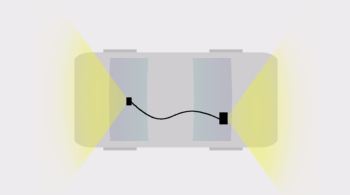 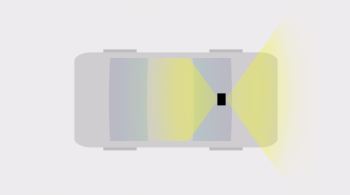
Multiple-camera digital recorders: These units operate just like the single-camera models, but record two separate views. Most are a self-contained unit that records a view of the inside of the car, including the driver, in addition to the standard view out of the front windshield. Some models use a second camera attached via wire to the primary unit, allowing the second camera to be placed anywhere the user desires (for example, to the rear of the vehicle). Like the single-camera units, these models also loop record the video to a memory card. In some cases, the unit records each video stream at a lower bitrate in order to facilitate the load of capturing two camera views at once. This type of dashcam is more commonly used on commercial fleet vehicles (such as buses and taxis) to provide evidence of the driver's actions in the event of an accident. Since most people are not comfortable with the idea of being constantly recorded, you don't typically see this type of unit being chosen for use in private vehicles.
Dual-camera dashcams, as you would expect, are more expensive than the single-camera units. Prices tend to range from $300 to over $400 for quality units. The consensus among dashcam users is that for the money, you are better off using two single-camera units for this task, as they are typically better at recording one video stream than a dual camera is at capturing two.
|
|
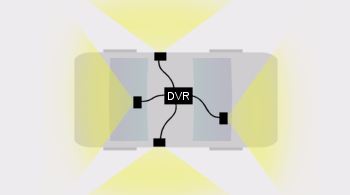
Conventional CCTV camera/DVR systems: A standard run-of-the-mill digital CCTV system, just like the ones in use at homes and businesses, can be used in a motor vehicle. All that is required is that the DVR be able to use the vehicle's power with an appropriate adapter. The advantages of a CCTV system include a very long recording loop (a week or more depending on the capacity of the DVR's hard drive) and many more camera views than the self-contained units. This type of system is used mostly on large commercial vehicles like tractor-trailers, buses and light rail trains. The old police car dashcams were essentially single-camera analog CCTV systems, with the tape recording unit in the trunk.
The main drawbacks of a CCTV system include their cost (starting at a couple thousand dollars) and that for the money, the resolution of each camera is typically much lower than the conventional single-camera dashcams. Most are recording standard-definition video (D1 resolution at best), which is not of sufficient quality to make out license plate numbers and faces. A few HD systems exist, but the recording bitrates per channel is usually not sufficient to capture the full HD resolution with any useful clarity. A CCTV system also requires running wires and installing multiple camera mounts, some of which may need holes drilled into the vehicle body and/or interior.
A CCTV system is probably not the best choice for private passenger cars and trucks. If additional camera views are desired, multiple single-camera units can accomplish that goal at a much cheaper cost and much higher video resolution per camera.
|
|
| Action cameras: Small cameras such as the GoPro or Contour can be mounted in a vehicle. The main benefit of these cameras is they typically have better resolution and picture clarity than most dashcam models. The drawbacks, however, include a much higher cost per camera and the lack of an appropriate loop-recording function that allows continuous, automatic hands-free operation. |
|
| Smartphones: Brackets are available that allow a video-equipped smartphone to be mounted as a dashcam. However, like the action cameras, the lack of loop recording and automatic operation make it impractical to use a phone in this way. To be effective in accomplishing its purpose, a dashcam must be dedicated to its task - installed and running hands-free at all times when the vehicle is in motion. |
Essential dashcam features
Back when I first wrote this page, many of the dashcam models available were missing important functions. While there are still a few being sold today that lack some of these essentials, dashcam manufacturers have for the most part cleaned up their act in this regard. Still, you should do your due diligence before buying.
Avoid any dashcam model that does not have ALL of the following functions:
- Automatic loop recording: "Loop recording" means that the camera continuously records in an indefinite loop hands-free without stopping, constantly overwriting the oldest video file with the newest video file. It works just like a CCTV system - at any time, you have an interval of time, up to the present, of your driving recorded. The loop recording function of a dashcam should automatically start/stop - beginning when you start your car and stopping when you turn of the ignition. A dashcam is supposed to be a "set it and forget it" device that you never have to think about until an accident or other incident is captured that you want to save.
- Seamless recording (no gaps between recorded files): Many of the cheaper dashcams available in the early 2010's were unable to seamlessly write the sequential video files to the memory card, resulting in a short gap in between every recorded file. For instance, a camera with this problem that is loop recording in 2-minute intervals would have a 2 or 3 second gap in between each file. That may not seem like much until something happens during that short gap that you wanted to record! On cameras with this problem, the gap worsens as file interval time increases. That is, a camera with this problem doing 15 minute recording intervals might have 15 seconds or more of a gap in between files. That's a lot of time that something could happen and be missed entirely. Again, while most manufacturers have corrected this issue with most of the new models available today, you still should ensure that your dashcam records with no gaps.
- True 1080 HD resolution: 1080 high-definition video is the de-facto standard for dashcams, and even higher resolutions are beginning to enter the scene. I would avoid anything recording in lower resolution. There's no real advantage, cost-wise or performance-wise, to settle for even 720p these days. Back in the early 2010's, there were many dashcam models fraudulently purporting to be HD, but actually were recording up-rezzed and cropped SD 4:3 widescreen video. This was a problem only noticed when the video was viewed on a large monitor. Again, you really don't have to worry much about this with most new dashcams available today, but it is worth double-checking.
- Full-motion (30fps) video: Some older and/or cheaper cameras record at less than 30 frames per second, which results in jerky video. Again, there's absolutely no reason to accept this when you can easily get full 1080p 30fps from virtually all new dashcam models on the market today.
- Heat resistance: Two of my older dashcams had problems shutting off unexpectedly when they got too warm from being in direct sunlight in a hot car. This problem was worse in the summer, as you'd expect. A dashcam is supposed to be permanently installed in the window of a car, so it must be able to withstand that type of environment. There are reports that even a few of the newer models on the market today aren't up to the task when it comes to high-temperature performance, so do your homework before you buy! As a general rule, dashcams that use a capacitor for power-down instead of a battery will fare better in high temperatures.
- Powered shutdown and file write: I haven't read about a dashcam that doesn't have this feature, but it's important. When the device loses power, it should have a short battery/capacitor charge to stay on long enough to save the last piece of video. If you have an accident and lose power, you want to make sure the camera saves the file!
- Wide-angle lens: Dashcams are available in a variety of lens types. Unfortunately, many don't specify exactly how wide each lens (in degrees) is. In the early years of dashcams, 70 degree and 120 degree lenses were common. Today, dashcam lenses - particularly HD models - are virtually all wide-angle that appear to be 120-140 degrees. Wider lenses capture a bigger field of view, but more distant subjects will be smaller in the frame. 70 degree lenses do a better job of capturing more distant subjects, but the reduced field of view could result in missing a lot of action. I personally feel that the wider lenses are better, particularly with HD resolution. The reason you want a dashcam is to capture things going on around you, not something far away.
Non-essential dashcam features
A number of dashcam models incorporate some price-increasing 'perks' that, while nice, you don't really need to spend the extra money on. These include:
- GPS logging: Cameras with this feature record your GPS position along with the video, which can be played back split-screen with a map using special software supplied.
- Speed logging:: Most of the GPS models can also log your speed and overlay this onto the video.
- G-force sensors: These show the g-forces associated with collisions or hard braking.
- Write-protect file save button: This feature is supposed to allow you to hit a button and write-protect the last file recorded in the event you capture something you want to save, then just let the camera keep running. I personally don't need this, because if the camera captures something, I want to immediately copy the files to my computer for safeguarding. Also, having a write-protected file(s) on the card means I have to go back and manually un-write protect it later at some point.
"Nice-to-have-but-not-deal-breakers" dashcam features
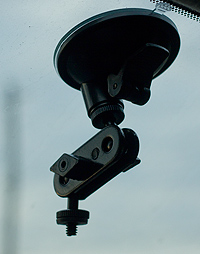 These are nice features for a dashcam to have, but not deal-breakers if they dont:
- Standard tripod mount: Dashcams with the standard 1/4" tripod nut/bolt (like the one pictured at right) give you a lot of flexibility in mounting, allowing you to use any of a wide variety of film/camera and custom mounts from countless sources. Many dashcams have proprietary mounts that can only be replaced with the same type. For instance, if the suction cup on a proprietary mount goes bad, you must go and buy the same mount as a replacement.
- Parking mode: This is a mode that can be manually activated if the dashcam is permanently hardwired to the vehicle's power instead of an ignition-controlled cigarette lighter outlet. Parking mode turns the dashcam into a motion-activated CCTV camera, allowing it to conserve the vehicle's battery power while capturing events when the vehicle is unoccupied.
- WIFI: These models allow the camera to be controlled and video viewed via a smartphone app, similar to a GoPro's wifi function.
New (potentially useful) dashcam features
A few of the newest models boast a few features that I think might have some promise. I cannot vouch for how well these work, so check up with user reviews as these develop:
- Red light/speed camera alerts: These dashcams compare a database of known speed cameras and red light cameras with your GPS position to alert you when you are approaching such a hazard.
- Collision warning: Models with this feature alert you when your closing speed on an approaching object/vehicle is hazardous.
Dashcam Tips
- Mount the cameras high: The higher the camera is, the better view of the road it will have.
- Make sure the camera is within the swath of your windshield wipers : You want your camera to be able to see the view ahead of you during rain, ice, frost or snow.
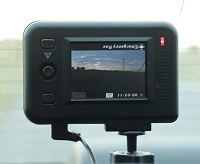 Cameras can be mounted upside down: There are cases where it may be easier to mount the camera upside-down. The video can then easily be flipped in any editing software once you get it copied to your computer. My rear-facing camera (pictured at right) is mounted this way since a suction cup will not hold due the rear window's defroster wires. If you mount a camera upside down, consider turning off the on-screen timestamp if the options menu gives you that choice. Cameras can be mounted upside down: There are cases where it may be easier to mount the camera upside-down. The video can then easily be flipped in any editing software once you get it copied to your computer. My rear-facing camera (pictured at right) is mounted this way since a suction cup will not hold due the rear window's defroster wires. If you mount a camera upside down, consider turning off the on-screen timestamp if the options menu gives you that choice.- Tripod mounts: If your camera came with a standard tripod mount and a suction cup can't be used, any tripod mount will work. My rear window with defroster wires won't hold a suction cup, so I built my own mount with aluminum bars. Again, you can mount the camera upside down if you have to.
- Powering on/off: Most dashcams are meant to be plugged into the car's cigarette lighter outlets that power off when the ignition is off. The cameras then start up by themselves once the car is started, and turn off when the keys are removed. If you are a storm chaser reading this, I would permanently connect the cameras to your 12-volt circuit that you use to power the rest of your stuff (inverter, battery chargers, streaming cams, etc). This frees up your cigarette lighter outlets from the clutter of a permanently installed device's wires. If your system is like mine and has a main power switch for the entire 12v circuit, you'll be able to leave the cameras running for times you're not with the vehicle (at a restaurant, gas station, etc).
- Run the cameras full-time: Keep the camera rolling at all times! Incidents happen when you least expect them, and the only way you'll catch them is to have the camera rolling. The only time my dashcams aren't rolling is when I'm home. When I'm in my car, they are always running.
- Use the biggest and fastest memory cards possible: Class 10 memory cards are a must. Slower cards can cause file errors, and they take forever to copy over to a computer. Most cameras come with 4GB cards that only give you a recording loop of less than an hour at 1080p resolution. That's really all you need if you just want to capture an accident, but if you'd like a longer record loop, get a bigger card. A 32GB card holds between 4 and 7 hours of 1080p h264 video (depending on the recording bitrate). I feel that the longer recording loop you have, the better - it's nice to be able to go back and review something that happened hours ago.
- If you catch something, save the video immediately: If you wait, the event may get overwritten at the end of the loop record cycle! You could also carry a couple of extra SD cards to swap out if the cameras catch something. Again, most cameras have a button that allows you to write-protect the current file, but if you do that all the time, eventually your card will be full of write-protected files that will shorten your recording loop.
- Disable the event detection: The event detection function will write-protect the current video segment if something trips the g-force sensors. This is supposed to safeguard the video file that captures an accident or other possibly damaging event. This seems like a good idea at first, but in practice, works against you. The problem is that most event detection functions are too sensitive (even on their lowest settings), and things like closing a car door or hitting a pothole will result in it triggering. With each new write-protected file, your memory card's available space will get smaller, and the dashcam's recording loop will shorten. Eventually, the card will fill up with these write-protected files, and the camera will stop recording! At that point, you'll need to re-format the memory card.
In practice, event detection is not necessary. Most dashcam users, me included, will immediately stop and copy the video file (or swap out the memory card) for safeguarding if something worthy is captured. If you get into an accident yourself, you normally wouldn't want to just let the camera keep recording until the crash was overwritten.
- Video codecs: Some of these cameras use unconventional codecs that many video editors/players won't recognize. My Aiptek and Garmin dashcams record h264 in an AVI wrapper, but Adobe Premiere will not read the video track natively (only the audio track comes in). I've had the best success using VLC to re-encapsulate files to .mp4 wrappers (keep video and audio track) in order to import them into Premiere.
Here is the process I use to convert these problematic dashcam files:
- With the VLC player open, go to File > Convert/Save
- The convert dialog box will appear. Click the Add button and browse for the file you want to convert.
- Click the Convert/Save button at the bottom of the window.
- Another dialog will appear. In the Profile drop down box, make sure Video - H.264 + MP3 (MP4) is selected.
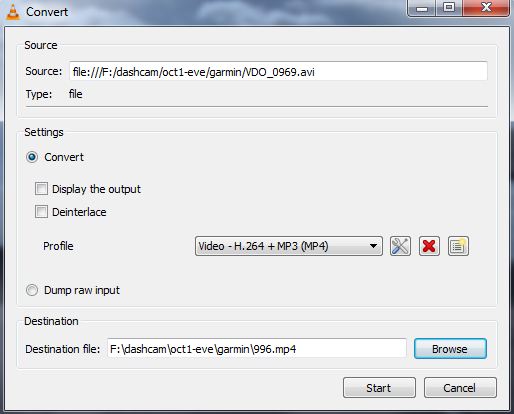
- Click the tool icon just to the right of Video - H.264 + MP3 (MP4) to open the "Profile edition" dialog.
- In "Profile edition" under the "Ecapsulation" tab, make sure MP4/MOV is selected.
- Switch to the "Video Codec" tab and make sure "Keep original video track" is selected.
- Switch to the "Audio Codec" tab and make sure "Keep original audio track" is selected.
- Click "Save"
- Click "Browse" and type the name of the converted file you want to create. Make sure it has the .mp4 extension.
- Click "Start".
If you did things correctly, the video file will simply be re-encapsulated into the MP4 wrapper after only a few seconds. The process should be done quickly since VLC is not re-encoding the actual video/audio track (which would take much longer).
Depending on the source file, the converted file may import into Premiere with both the video and audio track together. Occasionally, however, only the video track will come in. In that case, you'll just need to bring in the original file (audio track only) and sync the audio track from the original file with the video track from the converted file. It's a convoluted and confusing process, but at least it works.
The dashcam reviews section grew too large to fit on this page, so I moved it to its own page. A new comparison videos and frames page has also been added to complement the reviews.
These are the models I've personally reviewed:
Models marked with (**) are out of production, but can occasionally be found on online auction sites.
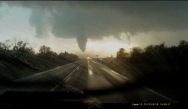 Dashcams for storm chasers Dashcams for storm chasers
One of the big reasons I use dashcams is to have a hands-off way to capture a complete video record of every storm chase (from as many angles as possible). If something interesting happens on a chase that I couldn't get a handheld camera on in time, I can pull the dashcam footage of said event later.
Here are a couple of my thoughts on storm chasing-related applications for dashcams:
- Dashcam as a streaming cam: Most dashcams are not designed to be a webcam/streaming camera, but many of them have HDMI or analog TV/RCA outputs that you can use for streaming if you have the right capture hardware on your laptop. Again, a dashcam is normally supposed to be a full-time fixed-view camera (wide angle, no zoom capability), so for most storm chasers a dedicated conventional video camera may still be the better choice for streaming. I consider dashcams to be supplemental "B cameras" and not a primary way to capture "A-roll" video.
I don't stream video of my storm chases, so I've never tried using one of my dashcams for that purpose.
- Dashcam or GoPro? Many storm chasers employ GoPros as their supplemental "B cameras" to capture full-event videos. A dashcam essentially serves the same purpose - but as a permanent fixture, it simply makes capturing full-event video a hands-off task in the sense that there is no setup/takedown or "start recording" task to attend to. A dashcam is always doing its thing, so at the end of the chase, the full video from each one is there for archiving if you so desire. GoPros generally have better video quality than a dashcam, but again, aren't as "hands-off".
After personally trying out my GoPro as a dashcam, I've concluded it is not well suited for the purpose. I go into more detail about this on the reviews page.
Keep in mind that a "real" dashcam will also be there for you for your daily driving (it was built for that to begin with), not just for your storm chases. You wouldn't normally mount your GoPro for your daily commute to work or trips to the grocery store. A dashcam will be faithfully recording every second of your driving both on chases and in daily life, with no intervention required until you capture something worth saving.
- Memory cards: You will want to use at least a 32GB Class 10 card in each dashcam you employ. That gives you roughly 5-7 hours of 1080p footage (depending on your camera's bitrate), enough time to capture most storm chases from start to finish. Most cameras support 64GB cards, which I am now using - giving me an over 9-hour long recording loop.
- Powering: I hardwire all of my dashcams to my car's primary 12v storm chasing equipment circuit (the one that powers the laptop, chargers, etc). This circuit is controlled by a manual power switch, and does not turn off when the ignition is off. You might want to consider doing this to allow the cameras to continue rolling even when the vehicle is turned off. I do this so I can leave the dashcams on during fuel/restaurant stops and pre-storm activities (waiting for initiation, etc).
Wish list: The ideal dashcam system
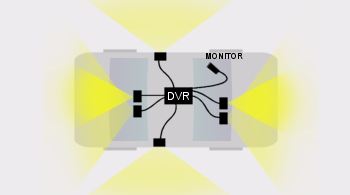
Dashcam manufacturers, this section is for you! These are the specs of what I would consider to be the ideal dashcam system for any vehicle:
- Six low-profile 1080p cameras: The cameras should be separate from the DVR unit and able to be placed anywhere inside or outside of the vehicle. The default setup for this would be wide-angle lens views to the front, back, driver's side and passenger side views. Since wide-angle lenses are terrible at capturing objects even just a few hundred feet ahead of the vehicle, an additional two narrow-angle camera views would be used for the front and back (to capture useful imagery of more distant events). The cameras should be minimal in size and their presence not obvious to a casual observer.
- High recording quality/bitrate: The cameras should be able to record in GoPro-like quality, with the option of bitrate selection.
- Central DVR unit: The DVR (recording) unit should be stowable in a not-readily-accessible location (like the trunk or under a seat) in order to be better shielded from heat and theft. Video from each camera should be stored on memory cards just like a standard single-unit dashcam, without compromising video quality.
- Alternatively: A modular/scalable system consiting of single-camera units (each with a small low-profile camera and separate DVR). Each camera should be able to send its video feed to a single (multiplexed) monitor on the car's dash. Cameras should come with a choice of lens (145, 120 and 70 degrees, for example).
Essentially, what I want is a 1080p digital version of a standard multi-camera CCTV system (with cameras, monitor and DVR all separate units), with six video recordings each of the same quality/bitrate that you would get with six single dashcam units. Or, a modular system consisting of single-camera units that can be multiplexed on a single monitor. If you are a dashcam manufacturer and make something like this, please let me know! |
Where to buy a dashcam
In the early years of dashcams (2010 or so) it was a challenge to find a place to buy one domestically. Since I first wrote this article, it has become much easier to find dashcams for sale in the USA. Many truck stops now have them in stock, and some major electronics retailers are beginning to carry them. I was able to get the Garmin Dash Cam 20 from a local Best Buy, which at last check had 5 or 6 different models on display (in the automotive electronics section).
As I mentioned a couple of other times on this page, you can save a considerable amount of money by ordering an equivalent unit direct from China or Taiwan (many are these are selling their product via eBay). However, you take the risk of having little recourse in the event of a defective unit or other problems. Reports of counterfeits and high-failure-rate units are also not uncommon with overseas sellers, so buyer beware! My personal recommendation is to buy domestic for a unit that comes with a warranty. As with most anything else, you get what you pay for. Dashcam videos
This page would not be complete without this link: the collection of videos that my dashcams have captured since 2007, which include several accidents and close calls. The most prominent of all of the videos is the El Reno tornado captured on all three cameras (the front, rear and side camera video links are on the chase log page). Disclaimer/about this page
This page started as a blog post in 2013, and due to its popularity, grew into its current form. This page and its contents are a personal, independent project not paid for or sponsored by any third party. I will accept demonstration models from dashcam manufacturers in order to write an impartial review. In those cases, the review will state clearly that the unit was sent to me for that purpose. A dashcam being sent to me free of charge will not influence the outcome of the review - that is, I will plainly describe any flaws or glitches I find during normal operation.
Recommended dashcams and manufacturers
The DashcamTalk web site and forum is the best place to check for up-to-date ratings of dashcams currently on the market. Dashcams and manufacturers to avoid
This is not a comprehensive list. Please contact me if you have a bad experience with a dashcam or a manufacturer, and I'll add them to this list if I receive enough corroborating reports.
- Vantrue: This Chinese manufacturer has been implicated in intellectual property theft, manipulation of online reviews/ratings systems and non-existent customer service.
Thanks Dan. An excellent tutorial on Dashcams.
- Posted by JM from BC, Canada | | |
Thank you very much for the post. I was looking for a dashcam and your review is very helpful. Usually, most of reviews talking about the specs and don't mention about heating issue, but it's very important to me here in Arizona. I think now I can pick one with more confidence. Thanks!
- Posted by Luka from Arizona | | |
This is very helpful - thank you. I need to find out how to permanently mount my camera for racing. I'm not allowed to use the suction mount as it could become a missile in an accident.
- Posted by Louise from Wollongong | | |
Very helpful. Thanks. I don't know what recording happens if we disable the loop recording intervals. Garmin GW-1 in my case
- Posted by Randy Henry from Titusville FL | | |
This was extremely helpful in helping me understand the features of my new dashcam. But the one I got has all of the features you listed and it was $40 at walmart. I have to admit, I hadn't thought about the heat and that might be an issue with it.
- Posted by Greg from Florida | | |
"These cameras record video files in 2, 5, 10 or 15 minute intervals" can you please explain this?
- Posted by Ket from India | | |
"Loop recording off / 30s / 1min / 2 min" Blaupunkt DVR 2.0 has this setting. What setting should I set?
- Posted by Ket from India | | |
thanks for your useful tips I'll be using some of them, I'm new to the world of dash cams and I am unfamiliar with some of the features and there purposes the manual I got does not explain there uses only how to adjust the setting can you please enlighten me on them and any suggestion that you might recommend e.g.. time laps settings, meter mode, loop record setting thanks for any help offered in this matter
- Posted by john from australian | | |
excellent tutorial
- Posted by Denis from Calgary,AB canada | | |
Thanks for the info!
- Posted by Constantin from Canterbury, UK | | |
I have a rear view mirror dash cam left it in the car and the glue holding the mirror on gave way and it fell apart you cannot leave it in a hot car
- Posted by Ray RT from Baltimore Md | | |
Hey there, is there a dash cam that is capable of streaming live video to say a home office, or smart phone ?
- Posted by Dan from Odessa, Tx. | | |
my husbands dash cam is perfect except for one thing,its recording upside down.while i know its not a problem because its the right way on the computer but its annoying any anwsers plz
- Posted by margaret long from shropshire | | |
Great write up for someone such as me that is looking to buy their first dash Cam. Very useful so thanks
- Posted by Terry Johnson from Hampshire, UK | | |
|
 These are nice features for a dashcam to have, but not deal-breakers if they dont:
These are nice features for a dashcam to have, but not deal-breakers if they dont:






 Introduction to dashcams
Introduction to dashcams




 Cameras can be mounted upside down: There are cases where it may be easier to mount the camera upside-down. The video can then easily be flipped in any editing software once you get it copied to your computer. My rear-facing camera (pictured at right) is mounted this way since a suction cup will not hold due the rear window's defroster wires. If you mount a camera upside down, consider turning off the on-screen timestamp if the options menu gives you that choice.
Cameras can be mounted upside down: There are cases where it may be easier to mount the camera upside-down. The video can then easily be flipped in any editing software once you get it copied to your computer. My rear-facing camera (pictured at right) is mounted this way since a suction cup will not hold due the rear window's defroster wires. If you mount a camera upside down, consider turning off the on-screen timestamp if the options menu gives you that choice.
 Dashcams for storm chasers
Dashcams for storm chasers